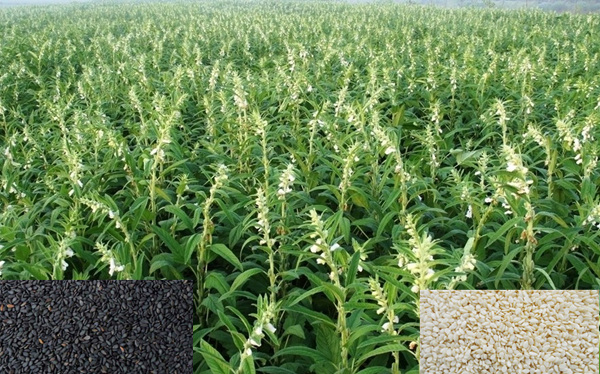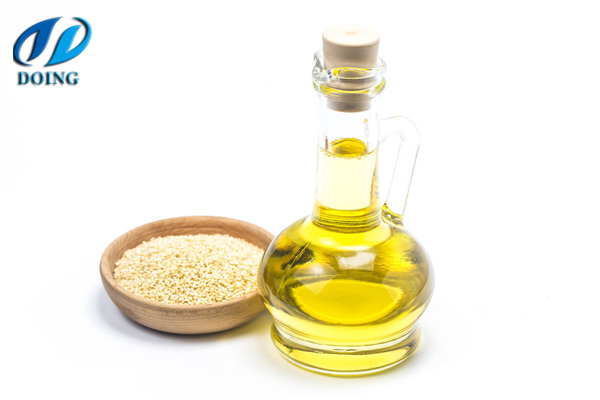A brief introduction of sesame
Sesame oil
Sesame (Sesamum indicum) is a flowering plant in the genus Sesamum. Numerous wild relatives occur in Africa and a smaller number in India. It is widely naturalized in tropical regions around the world and is cultivated for its edible seeds, which grow in pods.
Sesame seed is one of the oldest oilseed crops known, domesticated well over 3000 years ago. It was a major summer crop in the Middle East for thousands of years, as attested to by the discovery of many ancient presses for sesame oil in the region.Sesame is drought-tolerant and is able to grow where other crops fail.
Sesame has one of the highest oil contents of any seed. With a rich nutty flavor, it is a common ingredient in cuisines across the world.Like other nuts and foods, it can trigger allergic reactions in some people.
The world harvested about 3.84 million metric tonnes of sesame seeds in 2010. The largest producer of sesame seeds in 2010 was Burma.The world's largest exporter of sesame seeds was India, and Japan the largest importer.

White sesame seed and black sesame seed
Description
It is an annual plant growing 50 to 100 cm (1.6 to 3.3 ft) tall, with opposite leaves 4 to 14 cm (1.6 to 5.5 in) long with an entire margin; they are broad lanceolate, to 5 cm (2 in) broad, at the base of the plant, narrowing to just 1 cm (0.4 in) broad on the flowering stem.
The flowers are yellow, tubular, 3 to 5 cm (1.2 to 2.0 in) long, with a four-lobed mouth. The flowers may vary in colour with some being white, blue or purple.
Sesame fruit is a capsule, normally pubescent, rectangular in section and typically grooved with a short triangular beak. The length of the fruit capsule varies from 2 to 8 cm, its width varies between 0.5 to 2 cm, and the number of loculi from 4 to 12. The fruit naturally splits opens (dehisces) to release the seeds by splitting along the septa from top to bottom or by means of two apical pores, depending on the varietal cultivar. The degree of dehiscence is of importance in breeding for mechanised harvesting as is the insertion height of the first capsule.
Sesame seeds are small. The size, form and colours vary with the thousands of varieties now known. Typically, the seeds are about 3 to 4 millimeters long by 2 millimeters wide and 1 millimeter thick. The seeds are ovate, slightly flattened and somewhat thinner at the eye of the seed (hilum) than at the opposite end. The weight of the seeds are between 20 and 40 milligrams.The seed coat (testa) may be smooth or ribbed.
Sesame seeds come in many colours depending on the cultivar harvested. The most traded variety of sesame is off-white coloured. Other common colours are buff, tan, gold, brown, reddish, gray and black.
Sesame seed is sometimes sold with its seed coat removed (decorticated). This is the variety often present on top of buns in developed economies.
Origins
Sesame seed is considered to be the oldest oilseed crop known to humanity. Sesame has many species, and most are wild. Most wild species of the genus Sesamum are native to sub-Saharan Africa. Sesame Indicum the cultivated type, originated in India.
Charred remains of sesame recovered from archeological excavations have been dated to 3500-3050 BC. Fuller claims trading of sesame between Mesopotamia and regions that are now Pakistan and India occurred by 2000 BC. Some reports claim sesame was cultivated in Egypt during the Ptolemiac period, while others suggest the New Kingdom
Records from Babylon and Assyria, dating about 4000 years ago mention sesame. Egyptians called it sesemt, and it is included in the list of medicinal drugs in the scrolls of the Ebers Papyrus dated to be over 3600 years old. Archeological reports from Turkey indicate that sesame was grown and pressed to extract oil at least 2750 years ago in the empire of Urartu.
The historic origin of sesame was favored by its ability to grow in areas that do not support the growth of other crops. It is also a robust crop that needs little farming support—it grows in drought conditions, in high heat, with residual moisture in soil after monsoons are gone or even when rains fail or when rains are excessive. It was a crop that could be grown by subsistence farmers at the edge of deserts, where no other crops grow. Sesame has been called a survivor crop.
The total global harvest was about 3.84 million metric tonnes of sesame seeds in 2010. The largest producer in 2010 was Burma (Myanmar), and the top three producers, Burma, India, and China, accounted for 50 percent of global production.
Sesame was grown on over 7.8 million hectares in 2010.
The global average yield of sesame seeds was 0.49 metric tonnes per hectare in 2010. The table in this section presents the 2010 production (million metric tons) and yields (metric tons per hectare) for the top ten producer countries.
The most productive sesame seed farms in the world were in the European Union with an average composite yield of 5.5 metric tonnes per hectare in 2010; Italy reported the best nationwide average yield of 7.2 metric tonnes per hectare.There is a large yield gap and farm loss differences between major sesame seed producers, in part because of knowledge gap, poor crop management practices and use of technology.
The white and other lighter coloured sesame seeds are common in Europe, the Americas, West Asia, and the Indian subcontinent. The black and darker coloured sesame seeds are mostly produced in China and southeast Asia. Africa produces a variety of sesame seeds.
Beginning in the 1950s, U.S. production of the crop has been largely centered in Texas, with acreage fluctuating between 10,000 to 20,000 acres (40 to 80 km2) in recent years. The country's crop does not make up a significant global source; indeed imports have now outstripped domestic production.
Trade
The world traded over a billion dollars worth of sesame seeds in 2010. The trade volume has been increasing rapidly in the last two decades.
Japan is the world's largest sesame importer. Sesame oil, particularly from roasted seed, is an important component of Japanese cooking and traditionally the principal use of the seed. China is the second largest importer of sesame, mostly oil-grade sesame. China exports lower priced food grade sesame seeds, particularly to southeast Asia. Other major importers are the United States, Canada, Netherlands, Turkey and France.
Sesame seed is a high value cash crop. Sesame prices have ranged between US$ 800 to 1700 per metric ton between 2008 and 2010.
Sesame exports sell across a wide price range. Quality perception, particularly how the seed looks, is a major pricing factor. Most importers who supply ingredient distributors and oil processors only want to purchase scientifically treated, properly cleaned, washed, dried, colour-sorted, size-graded and impurity-free seeds with a guaranteed minimum oil content (not less than 40 percent) packed according to international standards. Seeds that do not meet these quality standards are considered unfit for export and are consumed locally. In 2008, by volume, by premium prices and by quality, the largest exporter was India, followed by Ethiopia and Myanmar.

